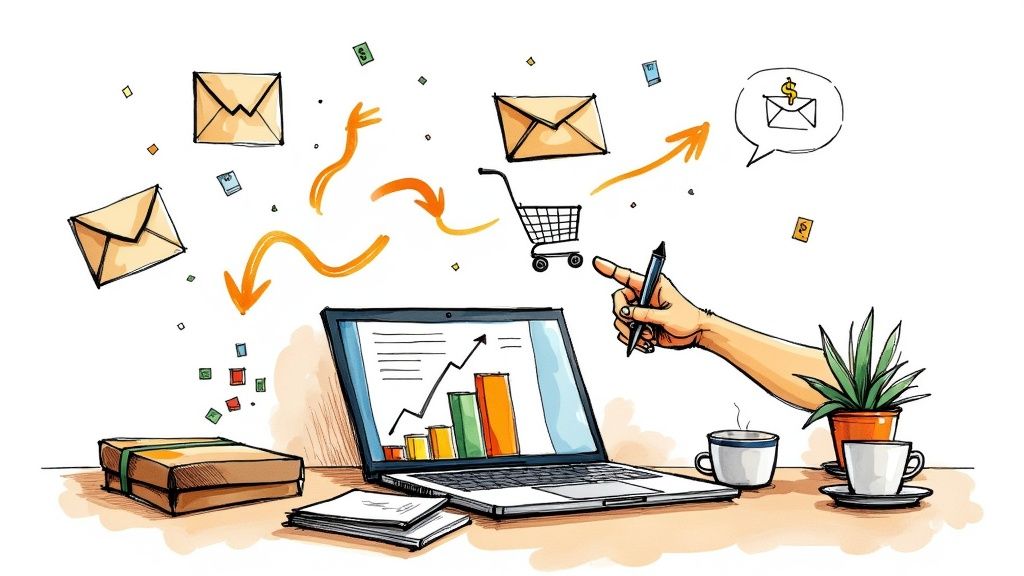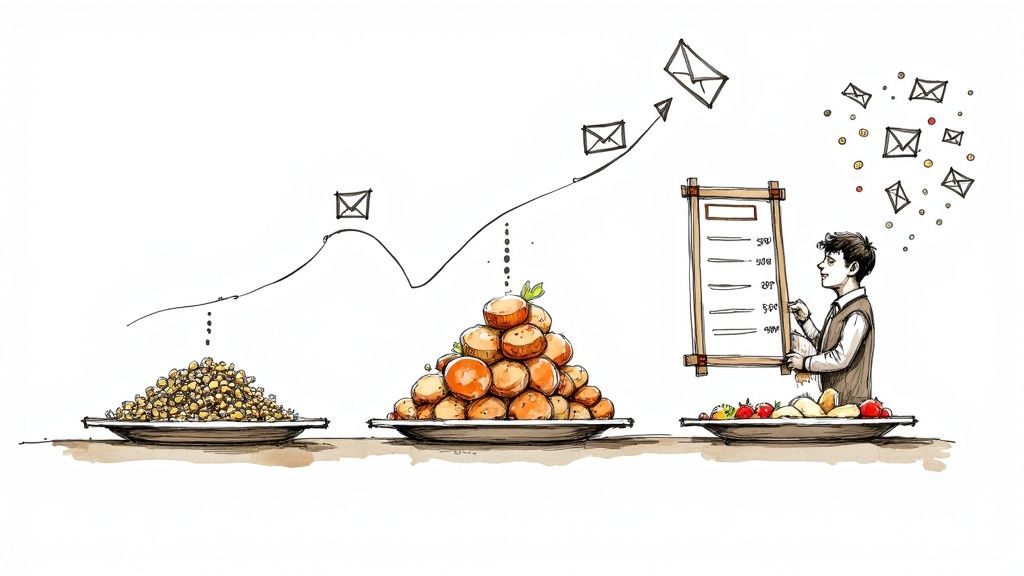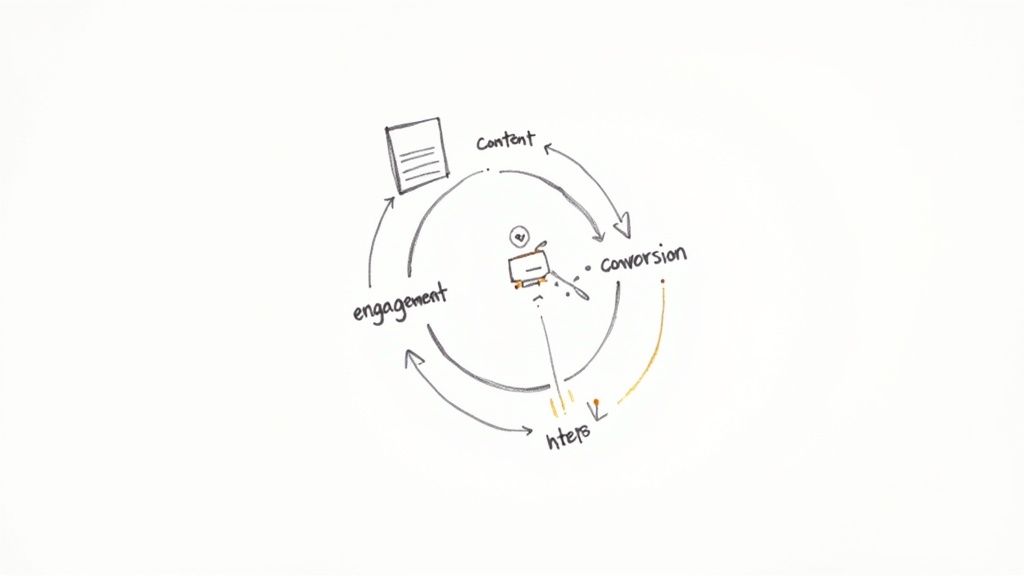Ecommerce Marketing Calendar: Your 2024 Success Blueprint

14 mins
6/6/2025
Joe Ervin
- ecommerce marketing calendar
- online marketing
- ecommerce planning
- retail strategy
- marketing automation
Why Your Store Needs An Ecommerce Marketing Calendar Now
Think of an ecommerce marketing calendar as your roadmap to success. It guides your promotional activities, ensuring you're always one step ahead. Without it, opportunities to boost sales and connect with customers can easily slip through the cracks.
Many store owners react to market trends, scrambling to replicate competitors' sales. However, savvy entrepreneurs understand the power of proactive planning. They map out their strategies months in advance, ensuring campaigns are well-prepared and effective. For example, a successful Black Friday strategy begins in September, not November.
This foresight yields significant returns. Businesses with dedicated marketing calendars often see increased sales during peak seasons. They avoid costly, last-minute marketing efforts that often fall flat. In fact, stores utilizing ecommerce marketing calendars experience up to a 35% higher average order value during holidays compared to those without a plan. Learn more about the advantages of a well-structured calendar: https://optinmonster.com/ecommerce-marketing-calendar/
Planning Ahead Pays Off
Advanced planning allows businesses to capitalize on key shopping dates. It's like preparing for a major event; you wouldn't wait until the last minute to handle logistics. An ecommerce marketing calendar provides the framework for organized and timely execution.
Avoid Costly Mistakes
Without a calendar, costly errors are more likely. Running out of popular products during a sale or promoting a sale too late are common pitfalls. A calendar serves as your checklist, minimizing these risks and ensuring smooth operations.
Start Simple, See Big Results
Don't be intimidated by complex tools. A simple calendar, such as Google Calendar, can be remarkably effective. Start by identifying a few important dates and outlining the necessary tasks for each, like inventory management, advertising, or email marketing. Even basic planning can significantly impact your sales.
Essential Dates Every Store Must Track
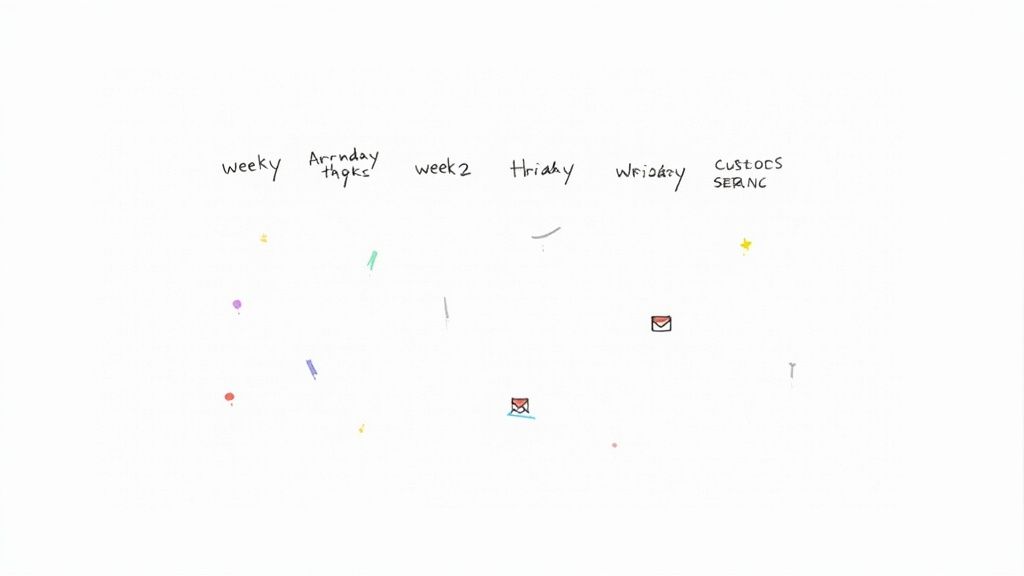
Smart planning is essential for a successful ecommerce marketing calendar. Knowing the optimal dates to promote your products can significantly increase sales. While major shopping holidays like Black Friday and Cyber Monday are crucial for most online stores, incorporating smaller, niche events tailored to your specific audience is equally important. A well-rounded calendar should blend these global sales opportunities with more targeted campaigns.
Global shopping days often generate substantial sales growth for online businesses worldwide. The ecommerce landscape is heavily influenced by these major retail holidays. Using a comprehensive ecommerce marketing calendar allows businesses to capitalize on these peak seasons. For example, in 2023, Black Friday generated $38 billion in global online sales, while Cyber Monday reached $12 billion. For a deeper dive into these statistics, check out this resource: Global Ecommerce Calendar 2025.
Big Sales Days to Remember
Here's a quick overview of major sales events to include in your planning:
- Singles' Day (November 11th): Originating in China, Singles' Day has gained international traction, presenting a prime opportunity for exclusive deals.
- Black Friday (Day after Thanksgiving): A retail behemoth in the US and beyond, Black Friday is known for its deep discounts across various product categories.
- Cyber Monday (Monday after Thanksgiving): This online-focused sales event often extends the Black Friday momentum, offering further deals and promotions.
- Amazon Prime Day (July): Amazon's Prime Day has quickly become a major summer shopping event, attracting significant consumer interest.
Don't Forget These Key Dates
While less prominent than major sales holidays, these smaller occasions can still provide valuable opportunities for boosting sales:
- Valentine's Day (February 14th): Beyond traditional gifts, many businesses can offer themed promotions and special deals for loved ones.
- Mother's Day (Second Sunday in May): This holiday provides an excellent opportunity to showcase gift ideas and promotions centered around moms.
- Father's Day (Third Sunday in June): Similar to Mother's Day, Father's Day offers a chance to promote gifts and deals specifically for dads.
- Back-to-School Season (July-September): This extended period is ideal for promoting school supplies, clothing, and other student essentials.
New Sales Events to Watch
The retail landscape is constantly evolving, with new sales events emerging. Consider these up-and-coming opportunities:
- Click Frenzy (Australia)
- Small Business Saturday
- Travel Tuesday
Make it Personal
Not every sales event will resonate with your specific target audience. Consider your products, customer demographics, and their purchasing habits. Understanding your audience's preferences and shopping patterns is key to selecting the right promotional dates. Think of it like choosing the right ingredients for a recipe – selecting the right elements leads to the best results.
To help you plan, here's a table summarizing key ecommerce marketing dates:
Key Ecommerce Marketing Dates by Quarter
This table outlines essential shopping holidays and events organized by season, along with their potential sales impact.
| Date | Event | Global Reach | Sales Impact | Best Product Types |
|---|---|---|---|---|
| November 11th | Singles' Day | International | High | Various |
| Day after Thanksgiving | Black Friday | International | Very High | Various |
| Monday after Thanksgiving | Cyber Monday | International | Very High | Electronics, Tech, Apparel |
| July | Amazon Prime Day | International | High | Various |
| February 14th | Valentine's Day | International | Medium | Gifts, Experiences, Confections |
| Second Sunday in May | Mother's Day | International | Medium | Gifts, Flowers, Experiences |
| Third Sunday in June | Father's Day | International | Medium | Gifts, Experiences, Electronics |
| July-September | Back-to-School Season | International | High | School Supplies, Clothing, Electronics |
This table offers a starting point for building your promotional calendar. Remember to adapt it based on your unique business needs.
By utilizing an ecommerce marketing calendar, you can proactively plan for these key dates, maximizing each opportunity and driving sales growth throughout the year. However, flexibility is also important. New shopping days may emerge, and consumer behavior can shift unexpectedly. Be prepared to adapt your calendar as needed to stay ahead of the curve.
Global Events Vs. Local Shopping Days That Matter
Your customers are scattered across the globe. This means your ecommerce marketing calendar needs to encompass more than just holidays in your own country. Different regions have their own unique shopping days, and neglecting these translates to lost sales opportunities. This section will guide you in creating a calendar that resonates with your target markets, wherever they may be.
Start With Global Events
Begin with major international events like Black Friday and Cyber Monday. These shopping extravaganzas are recognized in numerous countries and offer a strong foundation for your global marketing strategy. They provide a familiar and reliable starting point for reaching a broad audience.
Explore Local Treasures
Next, delve into local holidays that present substantial opportunities for growth. For instance, Diwali in India is a major driver of online sales, generating weeks of increased shopping activity. Chinese New Year also triggers significant online spending. Even in a market like Brazil, there are major sales events that many businesses overlook.
Country-specific holidays play a crucial role in ecommerce marketing, particularly when targeting international customers. Diwali sales in India, for example, can experience a remarkable 60% surge compared to typical sales figures. You can discover more detailed statistics here: Country-Wise Marketing Calendar 2025
Finding the Right Local Events
Learning which local events to incorporate into your calendar is essential. We’ll guide you through the process of discovering relevant holidays in the countries you're targeting. This research is paramount for building stronger customer relationships and driving sales within specific regions.
Balancing Global and Local
You can't realistically run sales every single day. Therefore, prioritizing the most impactful events is critical. We'll provide a straightforward method for ranking holidays, enabling you to determine which ones hold the greatest significance for your specific store and products. This strategic approach concentrates your efforts on the most lucrative events.
Research Your Audience
Understanding your target audience is another vital element. Consider which holidays they observe and which events hold meaning for them. By aligning your promotions with their cultural interests, your marketing campaigns become more resonant and impactful. It's about making a genuine connection with your customers on a personal level.
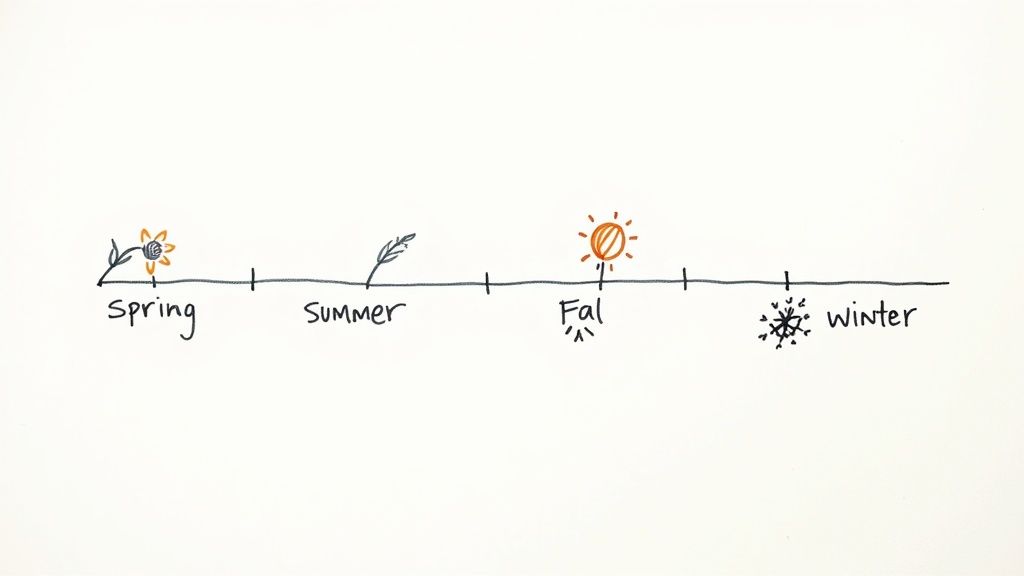
Don't Forget Smaller Moments
While major holidays offer significant sales potential, smaller, niche events can also yield impressive results. Think about incorporating events like "National [Your Product] Day" or events specific to your industry. These smaller-scale opportunities frequently have less competition, providing a chance for your brand to shine and attract a dedicated audience.
By strategically combining global and local events, your ecommerce marketing calendar can effectively engage a broader audience and drive sales consistently throughout the year. This balanced strategy maximizes your reach while still allowing for personalized, targeted campaigns.
Building Your First Ecommerce Marketing Calendar Step-by-Step

Ready to create your own ecommerce marketing calendar? This section provides a simple, step-by-step guide, perfect even for beginners.
Choosing Your Tools
The first step is selecting the right tool. There's no need for complex software. A simple tool like Google Calendar is more than sufficient for most online stores. We'll walk you through a quick setup process.
Pick Your First Dates
Next, choose a few key dates. Don't feel pressured to plan the entire year at once. Start with 5-10 major holidays. Consider Black Friday, Cyber Monday, and any holidays relevant to your specific products.
Work Backwards From Each Date
Now, work backwards from the dates you've selected. For instance, if you're planning a Black Friday sale, planning should begin well before November. Ask yourself these important questions:
- When should I create my advertisements?
- When should I order additional products?
We'll provide easy-to-use templates to help you navigate this process.
Different Campaigns, Different Timing
Remember that different campaigns require different timelines. Email campaigns are distinct from social media posts. Major product launches require more extensive planning than quick flash sales. We’ll show you how to effectively time each campaign type. For more information, explore our article on marketing automation for ecommerce.
Your First Ecommerce Marketing Calendar
By the end of this section, you'll have a functional calendar designed to boost sales. It acts as a convenient guide, ensuring you're always prepared for the next crucial step.
Example: Planning for Black Friday
Let's illustrate this with a Black Friday sale example. Here's a potential planning timeline:
- September: Finalize sale details and product selection. Begin creating your ads and other marketing assets.
- October: Secure sufficient product inventory to meet anticipated demand. Start your email and social media campaigns to generate excitement.
- Early November: Send sale reminders. Ensure your website can handle a surge in traffic.
- Black Friday: Execute your sale! Be available to address customer inquiries and ensure a smooth experience.
Simple Steps to Success
Creating an ecommerce marketing calendar is straightforward. Here’s a recap:
- Select a user-friendly tool like Google Calendar.
- Choose your initial key dates.
- Work backwards from each date to develop a plan.
- Consider the optimal timing for different campaign types.
You might be interested in: How to master...
Following these simple steps allows you to create an effective calendar. This calendar will enhance your marketing strategy and drive stronger sales. It's a valuable tool for growth, regardless of your store's size.
Perfect Timing For Every Type Of Campaign
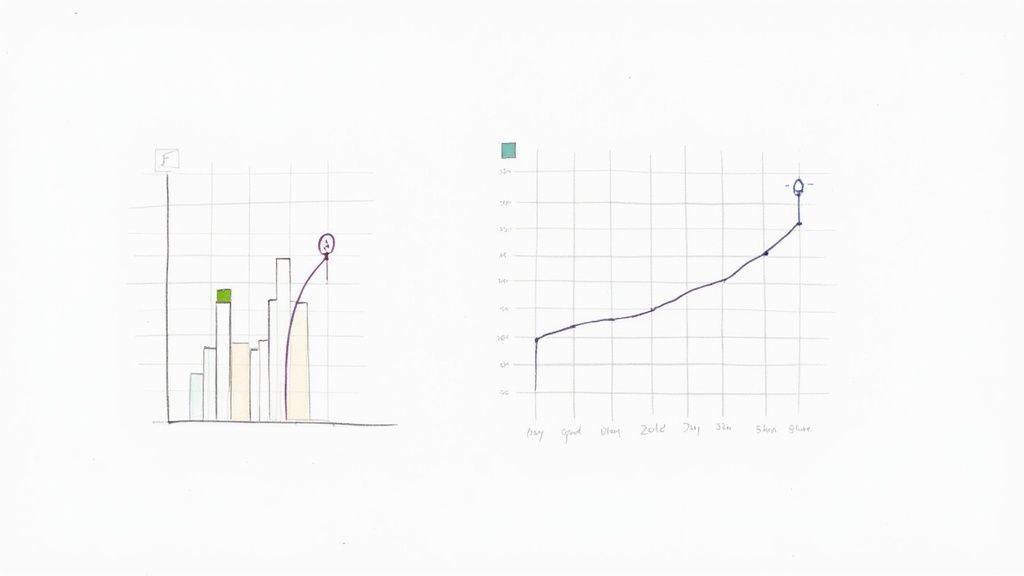
Knowing when to launch your campaigns is just as important as knowing what to promote. A well-timed email can result in a sale, while a poorly timed one might be ignored. This section explains how to time different types of campaigns for maximum impact. We'll explore emails, social media, inventory planning, and content creation.
Email Marketing: Reaching Your Audience at the Optimal Moment
Email is a primary communication tool for most businesses. Getting the timing right is crucial for success. Sending emails too early risks customers forgetting about your sale. Sending them too late might mean they've already purchased elsewhere.
Consider the number of emails sent before a big sale. Avoid overwhelming your customers. Space out your emails over several days or a week. A good practice is sending 3-4 emails leading up to a sale. This provides sufficient reminders without being excessive.
Think about when people check their email. Weekdays, particularly Tuesdays and Thursdays, often see the best open and click-through rates. Avoid sending emails on weekends when people are less likely to engage with shopping deals.
Social Media: Understanding the Rhythm of Each Platform
Timing on social media is more complex, as each platform operates differently. What works on Instagram may not be effective on Facebook. Observe when your audience is most active on each platform. This will maximize reach and improve results from ads and organic posts. Experiment to discover what works best for your specific audience.
Inventory Planning: Preventing Stock Shortages
Running out of popular products during a sale can negatively impact your business. Anticipate demand and ensure sufficient stock before the sale begins. Analyzing past sales data can help estimate the necessary product quantity.
Content Creation: Allowing Ample Time
Creating compelling content, including photos and videos for your ads, requires time and effort. Don't rush the process. Plan your content creation well in advance of your promotions.
Having visuals and ad copy ready beforehand allows for smooth sale execution. This provides opportunities for revisions, ensuring a polished final product.
Example: Orchestrating a Mother's Day Promotion
Consider a Mother's Day sale. You could send an initial email two weeks prior, reminding people to shop for gifts. Follow up with another email a week before, showcasing top gift ideas. A final reminder a day or two before Mother's Day can capture last-minute shoppers.
On social media, post photos and videos of your products in the weeks leading up to Mother's Day. Targeted ads can reach those specifically searching for gifts. Ensure adequate inventory of popular Mother's Day items. Begin creating your ad content at least a month in advance to allow ample time for revisions and refinement.
By meticulously planning the timing of each campaign component, you'll improve the chances of a successful promotion. A well-structured ecommerce marketing calendar helps reach the right people at the right time with the right message.
Tools And Templates That Save Hours Each Week
Building an ecommerce marketing calendar doesn't have to be a daunting task. Savvy business owners leverage tools and templates to streamline the process. Let's explore some free and paid options that can help you save valuable time.
Simple Spreadsheet Templates
Free spreadsheet templates are a readily available resource. Many include major holidays and provide suggested campaign timelines. These templates are a perfect starting point, especially if you're just beginning. Think of them as a pre-drawn sketch – the basic structure is there, and you add your own creative touches.
Specialized Calendar Software
For businesses seeking advanced features, marketing calendar software is an excellent choice. Some tools integrate directly with your email or social media accounts, such as Mailchimp or Hootsuite. This streamlines the scheduling of posts and simplifies tracking results.
Choosing the right tool depends on your store's size and budget. It's similar to selecting the right vehicle. A small business might need a compact car, while a larger enterprise might require a heavy-duty truck.
Check out our guide on How to master customer retention...
Automation Tricks
Automation can further enhance efficiency. Set up reminders for seasonal campaigns to stay ahead of the game. Some advanced tools even suggest campaign ideas based on your specific product offerings. This is like having a virtual assistant prompting you with timely reminders and helpful suggestions.
Tracking Your Progress
Monitoring campaign performance is crucial for continuous improvement. Analyze which strategies are successful and which ones fall short. This allows your calendar to evolve and become more effective over time. Think of it as analyzing game statistics – you identify strengths and weaknesses to refine your strategy.
Campaign Templates
Leveraging templates for various campaign types provides a valuable framework. This accelerates the creation of emails, social media posts, and other marketing materials, eliminating the need to start from scratch. It's like using a tried-and-true recipe – you have the basic ingredients and steps, and you can add your own personal flair.
Choosing The Right Tools for You
To help you choose the right tool for your needs, let's compare some popular options. The following table provides a breakdown of free and paid marketing calendar tools, highlighting their key features and pricing.
Ecommerce Calendar Tools Comparison: Free vs paid marketing calendar tools with features and pricing breakdown
| Tool Name | Type | Price | Key Features | Best For |
|---|---|---|---|---|
| Google Calendar | Free | Free | Basic scheduling, reminders | Small stores, simple needs |
| Trello | Free/Paid | Free/$Paid | Project management, collaboration | Teams, complex projects |
| Asana | Free/Paid | Free/$Paid | Project management, task assignment | Teams, detailed tracking |
| CoSchedule | Paid | $$ | Social media scheduling, content approval | Medium to large stores, social media focus |
| Later | Paid | $$ | Instagram scheduling, analytics | Instagram-focused businesses |
| SproutSocial | Paid | $$$ | Social media management, reporting | Large stores, multi-platform social media |
This comparison table offers a quick overview of various tools. Selecting the best fit for your specific needs is essential.
Planning Your Time Wisely
Effective time management is just as important as meticulous campaign planning. Allocate specific time slots each week or month to work on your ecommerce marketing calendar. This promotes organization and prevents last-minute scrambles. It's like scheduling an important meeting – it ensures that you dedicate the necessary time to your marketing efforts.
By utilizing the right tools and templates, you can build a robust ecommerce marketing calendar without sacrificing countless hours each week. Remember, even small incremental improvements can yield significant results over time. It's like nurturing a plant – consistent care and attention will help it flourish.
Key Takeaways
Creating a successful ecommerce marketing calendar involves careful planning, strategic execution, and continuous improvement. This section outlines the key steps in an action plan you can use immediately.
Building Your Action Plan
Building a calendar isn't simply listing dates. It's about outlining all the steps needed for a winning strategy. It's similar to planning a road trip: you need to know your destination and the route you'll take to get there.
Choose Your Tool: Start with a simple tool like Google Calendar. It's a reliable starting point, much like choosing a dependable car for your road trip.
Prioritize Key Dates: Focus on 5-10 important holidays and events relevant to your business. Don't overextend your efforts initially. Think of it as packing light for your trip–bring only the essentials.
Work Backwards: After choosing your dates, plan the preceding steps for each event. This ensures timely preparation for everything, from inventory to email campaigns. It’s like meticulously mapping your route and scheduling necessary stops for gas and food.
Setting Realistic Timelines
Different marketing campaigns require different timeframes. Email, social media, and product launches all have their own unique pace. Imagine them as different modes of transportation: a plane is quicker than a train, which is faster than a car.
Email Marketing: Plan email sequences weeks in advance. Schedule emails to maximize open rates, typically on weekdays. This is comparable to selecting the most efficient train schedule.
Social Media: Factor in the specific timing of each platform. Posting on Instagram requires a different strategy than on Facebook or Twitter. It's akin to choosing between a scenic route or a fast highway.
Product Launches: Product launches demand more lead time than flash sales. Content creation, inventory management, and marketing materials require careful coordination. This is similar to planning a cross-country road trip, where accounting for every detail is crucial.
Tracking Progress and Making Adjustments
Your calendar isn't set in stone. You need to track its performance and make adjustments as needed. Think of it as checking your GPS during a road trip and rerouting based on traffic or road closures.
You might be interested in: Learn more about ecommerce content marketing examples
Templates and Tools to Simplify Your Work
Leverage templates for different campaign types, like sales promotions or product launches. Numerous free and paid tools can help streamline your workflow. These tools are comparable to handy travel apps that assist with navigation, booking accommodations, and discovering interesting locations.
Scaling Your Calendar as You Grow
Your calendar should evolve with your store. As your business grows, add more dates and refine your strategies. This ensures your marketing remains organized and impactful. It's like upgrading to a larger car as your family expands.
Quick Wins This Week
Begin with small, achievable steps. For example, select an upcoming holiday and develop a basic plan. This initial momentum builds confidence and helps you master the process. It’s akin to taking a short test drive before embarking on a long journey.
By implementing these straightforward actions step-by-step, you can create an effective ecommerce marketing calendar and generate consistent growth for your online store. It's like having a reliable GPS guiding your journey, helping you reach your destination efficiently.
